Chapter 1 – Regional Progress on the Health-Related MDGs
 The prominence of health in the MDG framework reflects widespread recognition of the strong links between health and socioeconomic development and the need to reduce inequities in both to achieve sustained progress in the world.
The prominence of health in the MDG framework reflects widespread recognition of the strong links between health and socioeconomic development and the need to reduce inequities in both to achieve sustained progress in the world.
Health has consequences for entire economies and societies through the direct economic costs of illness and disabilities as well as through its impact on individual development, productivity, and creativity. At the same time, social determinants such as poverty, educational levels, discrimination, and other forms of social exclusion all impact health throughout the course of life through such variables as prenatal and childhood nutrition, living and workplace conditions, health knowledge and behaviors, and access to health goods and services. Therefore, progress on all the MDGs is needed, to some degree, to facilitate and sustain progress in health outcomes, creating social cohesion and building stronger citizenship for every person.
While Chapter 2 of this report will highlight PAHO/WHO technical cooperation in relation to nearly all the MDGs, this chapter focuses on the status of progress in the Americas on those Millennium goals and targets that are most directly related to health: MDG-1 target C, MDG-4, MDG-5, MDG-6, MDG-7 targets C and D, and MDG-8 target E.
MDG-1 Eradicate Extreme Poverty and Hunger
|
Target C: Halve, between 1990 and 2015, the proportion of people who suffer from hunger Indicators: Prevalence of underweight children under 5 Proportion of population below minimum level of dietary energy consumption |
 More than half of Latin American and Caribbean countries and territories for which data are available seem to be on track at the national level to achieve the official MDG targets on hunger, according to the 2010 ECLAC report Achieving the MDGs with Equality in Latin America and the Caribbean: Progress and Challenges. These targets focus on minimum calorie requirements, defined as 1,800 kcal per day per person in the Americas, and child malnutrition defined as low weight–for-age (underweight).
More than half of Latin American and Caribbean countries and territories for which data are available seem to be on track at the national level to achieve the official MDG targets on hunger, according to the 2010 ECLAC report Achieving the MDGs with Equality in Latin America and the Caribbean: Progress and Challenges. These targets focus on minimum calorie requirements, defined as 1,800 kcal per day per person in the Americas, and child malnutrition defined as low weight–for-age (underweight).
Eight countries and territories have already attained the target on minimum calorie requirements: Cuba, Guyana, Jamaica, Netherlands Antilles, Nicaragua, Peru, St. Vincent and the Grenadines, and Uruguay. Eight more countries appear set to achieve that target: Bahamas, Brazil, Chile, Colombia, Costa Rica, Ecuador, Honduras, and Suriname (ECLAC/FAO).
In contrast, seven countries have made less progress than needed to meet the minimum calorie target by 2015: Argentina, the Dominican Republic, Haiti, Panama, Paraguay, the Plurinational State of Bolivia, and Trinidad and Tobago. Seven others have made no progress or are less able to meet their populations’ minimum nutrition needs now than 20 years ago: the Bolivarian Republic of Venezuela, El Salvador, Grenada, Guatemala, Mexico, St. Lucia, and St. Kitts and Nevis (ECLAC/FAO).
It is important to note that in several countries that have made progress, 20 percent or more of their populations still consumes less than the minimum calorie needs. These include Haiti (with 58 percent), Bolivia (23 percent), the Dominican Republic (21 percent), and Nicaragua (21 percent), as well as the Caribbean subregion as a whole (23 percent) (ECLAC/FAO).
In contrast, six countries have less than 5 percent of their populations consuming less than their minimum calorie needs: Argentina, Chile, Costa Rica, Cuba, Mexico, and Uruguay (ECLAC/FAO).
 According to the available data on child malnutrition (low weight-for-age), Latin America and the Caribbean as a whole have reduced this indicator by 20 percent more than would be needed to meet the MDG target by 2015.
According to the available data on child malnutrition (low weight-for-age), Latin America and the Caribbean as a whole have reduced this indicator by 20 percent more than would be needed to meet the MDG target by 2015.
However, progress varies significantly across countries. Twelve countries are ahead of schedule: Bolivia, Brazil, Chile, the Dominican Republic, Ecuador, Guatemala, Guyana, Honduras, Mexico, Nicaragua, Peru, and Venezuela. Belize and Jamaica have progressed since 1990, but less than what is needed to meet the target by 2015. Argentina, Costa Rica, and Uruguay have rates of child malnutrition of less than 5 percent (2005), making it very likely they will reduce it to below 2 percent by 2015, effectively eradicating malnutrition (ECLAC/WHO/UNICEF).
Measures of malnutrition that are equally or more meaningful in the regional context than the official MDG indicators are also worth examining to assess progress toward eradicating hunger. Levels of acute malnutrition, defined as low weight-for-height, have been stable in most of the Region over the past two decades. But the problem has re-emerged in several countries—including Bolivia, Guatemala, Haiti, and Honduras—with high case-fatality rates when not properly treated.
Moreover, chronic malnutrition, measured as low height-for-age (stunting), continues to be a serious health problem in the Region, affecting an estimated 9 million children and contributing significantly to child mortality. Throughout Latin America and the Caribbean, the prevalence of stunting is significantly higher than the prevalence of underweight. Here too, however, the trend is mostly positive: in all countries for which representative data are available, rates of stunting have declined in recent years. Six countries in Latin America—Brazil, Colombia, the Dominican Republic, El Salvador, Mexico, and Nicaragua—are on track to reduce stunting by half by 2015, while Bolivia, Costa Rica, and Haiti are within 3 percentage points of being on track. Stunting remains most serious in Central America and the Andean countries, affecting half of Guatemalans and a quarter to a third of Bolivians, Ecuadorans, Haitians, Hondurans, and Peruvians.
 Micronutrient deficiencies—in iron, vitamin A, and iodine, for example—are also significant nutritional problems in the Region, though they are not MDG indicators. The prevalence of anemia in young children has declined very little, from 34 percent to 33 percent over 10-12 years, in 16 countries for which there are trend data. Among non-pregnant women of childbearing age, anemia declined only slightly, from 21 percent to 20 percent during a similar period. The trend is better among pregnant women: anemia prevalence in this group declined from 43 percent to 28 percent in 15 countries over 10 years. Improvements have also been seen in iodine deficiency disorders. Data are not available to assess progress in vitamin A deficiency.
Micronutrient deficiencies—in iron, vitamin A, and iodine, for example—are also significant nutritional problems in the Region, though they are not MDG indicators. The prevalence of anemia in young children has declined very little, from 34 percent to 33 percent over 10-12 years, in 16 countries for which there are trend data. Among non-pregnant women of childbearing age, anemia declined only slightly, from 21 percent to 20 percent during a similar period. The trend is better among pregnant women: anemia prevalence in this group declined from 43 percent to 28 percent in 15 countries over 10 years. Improvements have also been seen in iodine deficiency disorders. Data are not available to assess progress in vitamin A deficiency.
While MDG hunger data have not been compiled for the United States and Canada, indicators show that in 2007, 0.8 percent of U.S. households with children had one or more of those children experiencing “very low food security,” that is, with irregular meals and food intake below levels considered adequate by caregivers (USDA). In 2007-2008, 2.7 percent of Canadian households were “severely food insecure,” that is, with reduced food intake and disrupted eating patterns because of insufficient money for food (CCHS/Health Canada).
MDG-4 Reduce Child Mortality
|
Target A: Reduce by two-thirds, between 1990 and 2015, the under-5 mortality rate Indicators: Under-5 mortality rate Under-1 mortality rate Proportion of 1-year-olds immunized against measles |
 The countries of the Americas have made significant progress in reducing both infant (under-1) and child (under-5) mortality. In Canada and the United States of America, where baseline rates were already low, recent changes have been small. Infant mortality declined 4 percent in Canada between 2001 and 2006 (from 5.2 to 5.0 per 1,000 live births). In the United States during the same period, infant mortality declined 7.4 percent (from 6.8 to 6.7 per 1,000).
The countries of the Americas have made significant progress in reducing both infant (under-1) and child (under-5) mortality. In Canada and the United States of America, where baseline rates were already low, recent changes have been small. Infant mortality declined 4 percent in Canada between 2001 and 2006 (from 5.2 to 5.0 per 1,000 live births). In the United States during the same period, infant mortality declined 7.4 percent (from 6.8 to 6.7 per 1,000).
As of 2009, Latin America and the Caribbean had the lowest infant mortality rate of any developing region, at 19 per 1,000 live births, as well as the fastest rate of decline (55 percent) since 1990. To attain the MDG target on reducing infant mortality by 2015, countries needed by 2009 to have achieved a reduction of at least 50.2 percent since 1990, meaning that the Region is generally on track to achieve MDG-4.
 This progress reflects a number of factors. They include expanded access to and improvements in critical primary healthcare interventions, such as immunization, support for breastfeeding, well-child care, and oral rehydration therapy for diarrheal diseases, as well as expansion of basic services for potable water and sanitation. Other important factors include higher educational levels, especially among women, lower fertility rates, and reductions in poverty levels.
This progress reflects a number of factors. They include expanded access to and improvements in critical primary healthcare interventions, such as immunization, support for breastfeeding, well-child care, and oral rehydration therapy for diarrheal diseases, as well as expansion of basic services for potable water and sanitation. Other important factors include higher educational levels, especially among women, lower fertility rates, and reductions in poverty levels.
These regional averages, however, mask major differences between countries. In addition to Canada and the United States, several countries and territories—including Chile, Costa Rica, Cuba, and Uruguay in Latin America; and Anguilla, Guadeloupe, French Guiana, and Martinique in the Caribbean—have achieved infant mortality rates of 10 per 1,000 or lower, comparable or better than in many developed countries. In contrast, Bolivia and Haiti have rates as much as eight times higher, between 50 and 80 deaths per 1,000 live births. Guyana, Suriname, and Trinidad and Tobago have rates between 20 and 40 per 1,000, by various estimates.
 There are also important disparities in infant mortality within the Region’s countries. In the United States, infant mortality is nearly twice as high among babies born to non-Hispanic black women as the national average—13 vs. 6.7 per 1,000 live births—and the rate among those born to Puerto Rican women is 44 percent higher than among non-Hispanic white women (CDC, 2006). In Latin America, estimates of deaths among children born to women aged 25 to 39 vary strikingly across small administrative divisions in a number of countries, ranging from less than 3 percent to over 25 percent in different areas of Mexico, Guatemala, Nicaragua, and Panama (CELADE, 2000). Disparities also exist between urban and peri-urban areas of major metropolitan areas, and between indigenous or ethnic groups and the general population, although the gaps are much larger in some countries than in others.
There are also important disparities in infant mortality within the Region’s countries. In the United States, infant mortality is nearly twice as high among babies born to non-Hispanic black women as the national average—13 vs. 6.7 per 1,000 live births—and the rate among those born to Puerto Rican women is 44 percent higher than among non-Hispanic white women (CDC, 2006). In Latin America, estimates of deaths among children born to women aged 25 to 39 vary strikingly across small administrative divisions in a number of countries, ranging from less than 3 percent to over 25 percent in different areas of Mexico, Guatemala, Nicaragua, and Panama (CELADE, 2000). Disparities also exist between urban and peri-urban areas of major metropolitan areas, and between indigenous or ethnic groups and the general population, although the gaps are much larger in some countries than in others.
As for child (under-5) mortality, Latin America and the Caribbean as a whole saw a decline of 79.1 percent between 1991 and 2009, and nearly all the countries had declines well over 50 percent, sufficient to achieve the target reductions by 2015 (CELADE and UN Population Division). As with infant mortality, however, actual rates continue to vary widely across countries and territories, ranging from more than 50 per 1,000 live births in Haiti, Bolivia, and Guyana to fewer than 10 per 1,000 in Chile, Cuba, and Guadeloupe.
MDG-5 Improve Maternal Health
|
Target A: Reduce by three-quarters, between 1990 and 2015, the maternal mortality ratio Indicator: Proportion of births attended by skilled health personnel Target B: Achieve, by 2015, universal access to reproductive health Indicators: Contraceptive prevalence rate Adolescent birth rate Antenatal care coverage Unmet need for family planning |
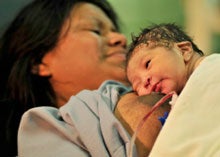 Maternal mortality varies dramatically across the countries of the Americas, from fewer than 50 deaths per 100,000 live births in Argentina, Canada, Chile, Costa Rica, Cuba, the United States, and Uruguay to a high of 630 deaths per 100,000 births in Haiti. In the Caribbean, the three countries with the highest maternal mortality are Suriname (184.3 deaths per 100,000 live births in 2007), Guyana (112.5 deaths in 2007), and Jamaica (95 deaths in 2001-2003) (PAHO Basic Indicators).
Maternal mortality varies dramatically across the countries of the Americas, from fewer than 50 deaths per 100,000 live births in Argentina, Canada, Chile, Costa Rica, Cuba, the United States, and Uruguay to a high of 630 deaths per 100,000 births in Haiti. In the Caribbean, the three countries with the highest maternal mortality are Suriname (184.3 deaths per 100,000 live births in 2007), Guyana (112.5 deaths in 2007), and Jamaica (95 deaths in 2001-2003) (PAHO Basic Indicators).
According to PAHO/WHO data, maternal mortality declined 40 percent in the Americas between 1990 and 2008, from 140 to 84 deaths per 100,000 live births. However, progress on this indicator is difficult to monitor because of data quality and coverage problems. Some countries have improved their reporting of maternal deaths, which can mask actual improvements in maternal mortality. Other countries are believed to undercount maternal deaths by as much as 50 percent. While the available data show that 15 countries in the Region experienced declines between 1990 and 2008, many did not, and most of the countries are unlikely to meet the MDG target by 2015.
Meanwhile, recent estimates suggest there are just over 10,000 maternal deaths in the Americas each year, many of them preventable through common interventions.
 Major contributors to maternal mortality include direct obstetric causes such as hypertensive disorders (preeclampsia and eclampsia), hemorrhage, abortion, and sepsis and other infections following childbirth. Indirect causes include infections such as HIV and vector-transmitted diseases, such as malaria, which are contributing factors to maternal deaths.
Major contributors to maternal mortality include direct obstetric causes such as hypertensive disorders (preeclampsia and eclampsia), hemorrhage, abortion, and sepsis and other infections following childbirth. Indirect causes include infections such as HIV and vector-transmitted diseases, such as malaria, which are contributing factors to maternal deaths.
Among the factors most closely related to maternal illness and deaths is the absence of skilled health personnel during delivery. The United Nations General Assembly in 1999 established a threshold of 90 percent of births with professional attention as a target for 2015. A number of countries in the Region—including Bolivia, Guatemala, Haiti, and Peru—lag far behind on this indicator; Honduras, Nicaragua, and Paraguay are also behind, though to a lesser degree (ECLAC). However, skilled attendance at birth alone cannot guarantee reductions in maternal mortality; equally important are the effectiveness and quality of care, along with delays in seeking more specialized medical attention.
 The target of universal access to reproductive health was added to MDG-5 in 2005, reflecting concerns that this is essential to improving maternal health and reducing maternal deaths. The indicators for this target are contraceptive prevalence, adolescent birth rate, prenatal care coverage, and unmet need for family planning.
The target of universal access to reproductive health was added to MDG-5 in 2005, reflecting concerns that this is essential to improving maternal health and reducing maternal deaths. The indicators for this target are contraceptive prevalence, adolescent birth rate, prenatal care coverage, and unmet need for family planning.
Overall, prenatal care coverage is relatively high in Latin America and the Caribbean, with more than three in four women having four or more prenatal visits in seven of 11 countries reporting data for this indicator (ECLAC). However, access to both prenatal care and assisted childbirth is much lower in rural areas and among indigenous and Afro-descendant populations.
As for adolescent fertility, births to women ages 15 to 19 remain high in Latin America and the Caribbean; they have only declined 7.2 percent since 1990 (ECLAC). Sub-Saharan Africa is the only region that has had a smaller decline in adolescent fertility (5.7 percent) during this period.
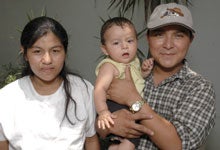 Unwanted pregnancies are believed to contribute to about one-fourth of maternal deaths (UN MDG Report 2007). In a number of countries in Latin America, contraceptive use among women of childbearing age remains low, although the gap between rural and urban areas has narrowed in most countries for which data are available (ECLAC). In addition, the majority of countries have reduced the unmet demand for family planning and narrowed gaps in access between different social sectors (ECLAC). Yet much progress remains to be made before every person in the Region has access to comprehensive and good-quality sexual and reproductive health services.
Unwanted pregnancies are believed to contribute to about one-fourth of maternal deaths (UN MDG Report 2007). In a number of countries in Latin America, contraceptive use among women of childbearing age remains low, although the gap between rural and urban areas has narrowed in most countries for which data are available (ECLAC). In addition, the majority of countries have reduced the unmet demand for family planning and narrowed gaps in access between different social sectors (ECLAC). Yet much progress remains to be made before every person in the Region has access to comprehensive and good-quality sexual and reproductive health services.
MDG-6 Combat HIV/AIDS, Malaria, and Other Diseases
|
Target A: Halt and begin to reverse the spread of HIV/AIDS by 2015 Indicators: HIV prevalence among population aged 15 to 24 Condom use at last high-risk sex Proportion of population ages 15 to 24 with comprehensive correct knowledge of HIV/AIDS Ratio of school attendance of orphans to school attendance of non-orphans aged 10 to 14 Target B: Achieve, by 2010, universal access to treatment for HIV/AIDs for all those who need it Indicator: Proportion of population with advanced HIV infection with access to antiretroviral drugs |
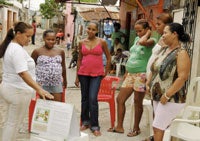 The HIV epidemic has had different impacts on different subregions of the Americas. With nearly 1 percent of adults (15 to 49) infected, the Caribbean has the highest HIV prevalence of any region of the world other than sub-Saharan Africa. In North, Central, and South America prevalence is estimated at 0.5 percent (UNAIDS).
The HIV epidemic has had different impacts on different subregions of the Americas. With nearly 1 percent of adults (15 to 49) infected, the Caribbean has the highest HIV prevalence of any region of the world other than sub-Saharan Africa. In North, Central, and South America prevalence is estimated at 0.5 percent (UNAIDS).
Recent trends in new infections also vary by subregion. Between 2001 and 2009, new infections in the Caribbean declined 15 percent (from 20,000 to 17,000) and in Central and South America, 7 percent (from 99,000 to 92,000), while during the same period, new cases increased 6 percent in North America (from 66,000 to 70,000). Regionwide, this added up to a 3 percent decline in new cases over the period.
 Changes in mortality have varied considerably across the Americas. In the United States and Canada, deaths from AIDS decreased dramatically following the introduction of highly active antiretroviral therapy (HAART). The number of deaths attributable to HIV in Canada decreased 76 percent from 1995 to 1999 and 16 percent from 2000 to 2006, the last year for which data are available (PHAC). The age-adjusted HIV death rate in the United States decreased 28 percent from 1995 to 1996, 46 percent from 1996 to 1997, and 18 percent from 1997 to 1998. After 1998, the annual decrease ranged from 3 percent to 8 percent (CDC). Nevertheless, AIDS remains one of the leading causes of death among people 25 to 44 years old in the United States, particularly among those who are black/African American or Hispanic.
Changes in mortality have varied considerably across the Americas. In the United States and Canada, deaths from AIDS decreased dramatically following the introduction of highly active antiretroviral therapy (HAART). The number of deaths attributable to HIV in Canada decreased 76 percent from 1995 to 1999 and 16 percent from 2000 to 2006, the last year for which data are available (PHAC). The age-adjusted HIV death rate in the United States decreased 28 percent from 1995 to 1996, 46 percent from 1996 to 1997, and 18 percent from 1997 to 1998. After 1998, the annual decrease ranged from 3 percent to 8 percent (CDC). Nevertheless, AIDS remains one of the leading causes of death among people 25 to 44 years old in the United States, particularly among those who are black/African American or Hispanic.
In Latin America, several countries—including Argentina, Brazil, Chile and Costa Rica—have significantly reduced HIV/AIDS mortality through expanded access to antiretroviral treatment (ART). In others—including Colombia, Ecuador, and Venezuela—HIV mortality remains stable or has increased.
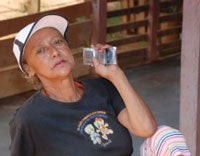 The groups most affected by the epidemic in the Americas continue to be men who have sex with men, injecting drug users, and sex workers. The proportion of women with HIV has stabilized at about 34 percent of all people living with HIV in Latin America and 48 percent of people with HIV in the Caribbean (UNAIDS/PAHO/UNICEF).
The groups most affected by the epidemic in the Americas continue to be men who have sex with men, injecting drug users, and sex workers. The proportion of women with HIV has stabilized at about 34 percent of all people living with HIV in Latin America and 48 percent of people with HIV in the Caribbean (UNAIDS/PAHO/UNICEF).
In terms of condom use, studies show that more men (69 percent) than women (40 percent) who have had more than one sexual partner during the previous 12 months report using condoms. In Latin America and the Caribbean only three countries have reported that condoms are available to adolescents in school (UNAIDS/WHO). Studies also show increasing use of condoms among sex workers and their clients, but gaps in prevention efforts remain, particularly among men who have sex with men and injecting drug users (UNAIDS/WHO).
 Knowledge of HIV transmission and prevention also varies widely across the Region’s countries. Estimates of the proportion of young women aged 15 to 24 with comprehensive correct knowledge about HIV vary from 9 percent in Guatemala to 89 percent in Argentina, while the proportion of young men with such knowledge ranges from 10 percent in Guatemala to 82.3 percent in Argentina (UNAIDS/WHO). In the Caribbean, the percentage of all young people with comprehensive correct knowledge was below 60 percent in 2007, ranging from a high of 56 percent in Trinidad and Tobago to a low of 5.2 percent in Aruba (UNDP/MND Belize).
Knowledge of HIV transmission and prevention also varies widely across the Region’s countries. Estimates of the proportion of young women aged 15 to 24 with comprehensive correct knowledge about HIV vary from 9 percent in Guatemala to 89 percent in Argentina, while the proportion of young men with such knowledge ranges from 10 percent in Guatemala to 82.3 percent in Argentina (UNAIDS/WHO). In the Caribbean, the percentage of all young people with comprehensive correct knowledge was below 60 percent in 2007, ranging from a high of 56 percent in Trinidad and Tobago to a low of 5.2 percent in Aruba (UNDP/MND Belize).
As for progress toward universal access to treatment for HIV, as of 2009, 50 percent of people in Latin America and the Caribbean who needed ART were receiving it, the highest level among low- and middle-income WHO regions. Coverage was higher for women (55 percent) than for men (49 percent) and even higher (58 percent) among children under age 15 who need ART. However, estimated coverage for children in the Caribbean was only 29 percent, compared with 68 percent of children in Latin America. The percentage of pregnant women living with HIV and receiving ART to prevent mother-to-child transmission of HIV increased from 19 percent in 2004 to 54 percent in 2009, with slightly higher coverage in the Caribbean (59 percent) than in Latin American countries (53 percent).
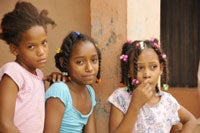 As with other MDG indicators, there are significant differences across countries in levels of ART coverage. Cuba and Guyana are currently the only countries in Latin America and the Caribbean that have achieved 80 percent coverage, the benchmark for “universal access” to ART (WHO, 2009). Seven other countries— Argentina, Brazil, Chile, Costa Rica, El Salvador, Mexico, and Suriname—had between 50 percent and 80 percent coverage as of 2009. Others had less than 50 percent coverage or lacked the data needed to estimate coverage levels.
As with other MDG indicators, there are significant differences across countries in levels of ART coverage. Cuba and Guyana are currently the only countries in Latin America and the Caribbean that have achieved 80 percent coverage, the benchmark for “universal access” to ART (WHO, 2009). Seven other countries— Argentina, Brazil, Chile, Costa Rica, El Salvador, Mexico, and Suriname—had between 50 percent and 80 percent coverage as of 2009. Others had less than 50 percent coverage or lacked the data needed to estimate coverage levels.
Argentina, Brazil, Ecuador, Guyana, and Jamaica are among only 11 developing countries worldwide that have reached the target of 80 percent coverage with ART to prevent mother-to-child HIV transmission. Half of the 14 developing countries worldwide that have reached 80 percent ART coverage for children are in the Region: Argentina, Brazil, Guyana, Jamaica, Panama, Paraguay, and Uruguay.
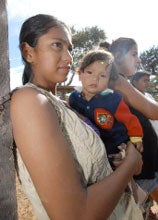 Assessing trends in ART coverage in Latin America and the Caribbean over the past decade is difficult because of data problems and changes in WHO criteria for who needs therapy and when. At the global level, WHO’s 2010 recommendation to change the CD4 cell count threshold for initiating ART resulted in an increase of 45 percent in the total number of people estimated to be in need of ART in 2009 in low- and middle-income countries.
Assessing trends in ART coverage in Latin America and the Caribbean over the past decade is difficult because of data problems and changes in WHO criteria for who needs therapy and when. At the global level, WHO’s 2010 recommendation to change the CD4 cell count threshold for initiating ART resulted in an increase of 45 percent in the total number of people estimated to be in need of ART in 2009 in low- and middle-income countries.
Easier to compare is the absolute number of people needing ART and having access to it over time. In Latin America and the Caribbean, this number grew from 192,000 in 2002 to 478,000 in 2009, for an increase of 149 percent. (Comparable data are not available on ART coverage in Canada and the United States.)
|
Target C: Halt and begin to reverse the incidence of malaria and other major diseases by 2015 Indicators: Incidence and death rates associated with malaria Proportion of children under 5 sleeping under insecticide-treated bed nets Proportion of children under 5 with fever who are treated with appropriate anti-malarial drugs Incidence, prevalence and death rates associated with tuberculosis Proportion of tuberculosis cases detected and cured under directly observed treatment short course |
 Click here to find out more about Tuberculosis on the web
Click here to find out more about Tuberculosis on the web
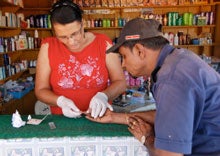 In the Americas, malaria remains endemic in the majority of countries (all except Canada, Chile, the United States, Uruguay, and the Caribbean Islands other than Hispaniola1). In the 21 endemic countries, coordinated control and treatment efforts have contributed to a 52 percent reduction in total malaria cases since 2000 and a 69 percent decline in deaths. Incidence decreased in 18 countries between 2000 and 2009, and in nine of these—Argentina, Belize, Costa Rica, Ecuador, El Salvador, Guatemala, Nicaragua, Paraguay, and Suriname—the decrease was more than 75 percent, effectively attaining the MDG target for malaria.
In the Americas, malaria remains endemic in the majority of countries (all except Canada, Chile, the United States, Uruguay, and the Caribbean Islands other than Hispaniola1). In the 21 endemic countries, coordinated control and treatment efforts have contributed to a 52 percent reduction in total malaria cases since 2000 and a 69 percent decline in deaths. Incidence decreased in 18 countries between 2000 and 2009, and in nine of these—Argentina, Belize, Costa Rica, Ecuador, El Salvador, Guatemala, Nicaragua, Paraguay, and Suriname—the decrease was more than 75 percent, effectively attaining the MDG target for malaria.
Four other countries—Bolivia, Brazil, Honduras, and Mexico—saw decreases of between 50 percent and 75 percent in malaria incidence. Venezuela, the Dominican Republic, and Haiti saw increases in malaria between 2000 and 2009, however, the trend since 2005 has been downward in all endemic countries except Haiti.
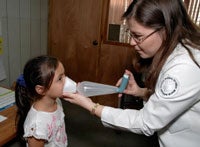 Much of this progress is due to successful efforts to monitor the development of resistance to malaria drugs and to adjust treatment regimens accordingly (these efforts are described in more detail in Chapter 2). For example, after changing its treatment policy in 2004 based on drug effectiveness studies, Suriname saw an 82 percent reduction in malaria cases over the next four years. Similar trends have been seen in Bolivia, Brazil, Colombia, Ecuador, and Peru.
Much of this progress is due to successful efforts to monitor the development of resistance to malaria drugs and to adjust treatment regimens accordingly (these efforts are described in more detail in Chapter 2). For example, after changing its treatment policy in 2004 based on drug effectiveness studies, Suriname saw an 82 percent reduction in malaria cases over the next four years. Similar trends have been seen in Bolivia, Brazil, Colombia, Ecuador, and Peru.
Tuberculosis incidence has been declining in the Region of the Americas since the 1980s, according to WHO data, and the decline accelerated following the widespread implementation of the directly observed treatment - short course (DOTS) strategy in the mid-1990s. According to WHO estimates, the Americas reduced TB prevalence from 97 cases per 100,000 inhabitants in 1990 to 38 per 100,000 in 2009 (a decrease of 60 percent) and the number of TB deaths from 8 per 100,000 in 1990 to 2 per 100,000 in 2008 (a 75 percent decline). Since both represent declines of more than 50 percent, the Region as a whole has already attained the target of having halted and begun to reverse the incidence of TB.
 Progress among individual countries, however, has been uneven. Chile, Costa Rica, and Cuba—along with Canada and the United States—have implemented TB elimination plans that have reduced incidence to less than 10 per 100,000 inhabitants, thus effectively achieving the MDG targets for TB. Fourteen other countries saw declines of over 50 percent in TB prevalence and mortality between 1990 and 2009, while 10 countries saw only modest declines. Six countries—Antigua and Barbuda, Belize, Jamaica, Paraguay, Suriname, and Trinidad and Tobago—had increases in incidence or deaths, or both, and are unlikely to meet the MDG target by 2015. Several of these countries have concurrent epidemics of HIV, and indeed co-infection with TB and HIV is a major challenge to overcome, along with multidrug-resistant TB (MDR-TB) and TB in marginalized populations in hard-to-reach areas. While all countries in Latin America focus some effort on diagnosis and treatment of TB in marginalized populations, their efforts generally fall short of what is needed to meet the Stop TB Partnership target of treating at least 85 percent of cases.
Progress among individual countries, however, has been uneven. Chile, Costa Rica, and Cuba—along with Canada and the United States—have implemented TB elimination plans that have reduced incidence to less than 10 per 100,000 inhabitants, thus effectively achieving the MDG targets for TB. Fourteen other countries saw declines of over 50 percent in TB prevalence and mortality between 1990 and 2009, while 10 countries saw only modest declines. Six countries—Antigua and Barbuda, Belize, Jamaica, Paraguay, Suriname, and Trinidad and Tobago—had increases in incidence or deaths, or both, and are unlikely to meet the MDG target by 2015. Several of these countries have concurrent epidemics of HIV, and indeed co-infection with TB and HIV is a major challenge to overcome, along with multidrug-resistant TB (MDR-TB) and TB in marginalized populations in hard-to-reach areas. While all countries in Latin America focus some effort on diagnosis and treatment of TB in marginalized populations, their efforts generally fall short of what is needed to meet the Stop TB Partnership target of treating at least 85 percent of cases.
MDG-7 Ensure Environmental Sustainability
|
Target C: Halve, by 2015, the proportion of people without sustainable access to safe drinking water and basic sanitation Indicators: Proportion of population using an improved drinking water source Proportion of population using an improved sanitation facility |
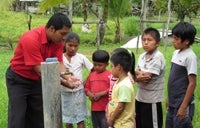 Access to water and sanitation, along with shelter, has been established as a human right and as essential for ensuring a basic quality standard for people’s living environments, which in turn are among the main social determinants of health.
Access to water and sanitation, along with shelter, has been established as a human right and as essential for ensuring a basic quality standard for people’s living environments, which in turn are among the main social determinants of health.
The Region of the Americas has significantly expanded access to drinking water and sanitation since 1990 and is well within reach of the respective MDG targets. The proportion of the population without improved drinking water declined from about 16 percent to 9 percent between the early 1990s and the mid-2000s, a 44 percent reduction over approximately one decade. The proportion of people without improved sanitation facilities declined from 32 percent to 22 percent during the same period, for a reduction of just over 30 percent over 10 years (ECLAC). This pace of progress is more than sufficient to reach the 50 percent reductions needed by 2015.
 Progress has also been made in reducing the gaps in access between urban and rural residents. The percentage of urban residents with access to improved drinking water increased from 95 percent in 1990 to 97 percent in 2008, while the proportion of rural dwellers increased from 63 percent to 80 percent. Nonetheless, in 2008, some 40 million people in the Region still lacked access to improved sources of drinking water, and some 115 million people were without improved sanitation facilities (WHO/UNICEF), leaving room for considerable progress even after the MDGs are met.
Progress has also been made in reducing the gaps in access between urban and rural residents. The percentage of urban residents with access to improved drinking water increased from 95 percent in 1990 to 97 percent in 2008, while the proportion of rural dwellers increased from 63 percent to 80 percent. Nonetheless, in 2008, some 40 million people in the Region still lacked access to improved sources of drinking water, and some 115 million people were without improved sanitation facilities (WHO/UNICEF), leaving room for considerable progress even after the MDGs are met.
MDG-8 Develop a Global Partnership for Development
|
Target E: In cooperation with pharmaceutical companies, provide access to affordable essential drugs in developing countries Indicator: Proportion of population with access to affordable essential drugs on a sustainable basis |
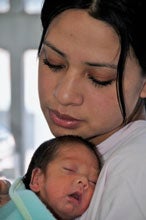 Access to affordable medicines
Access to affordable medicines
Data on access to medicines are not widely available in the Americas, making it difficult to assess MDG progress in this area. A recent PAHO/WHO study in Guatemala, Honduras, and Nicaragua found that, on average, 80 percent of households had access to medicines for common health conditions, including acute and chronic diseases and pregnancy. Out-of-pocket expenditures on medicines averaged 58 percent of total household health expenditures.
In terms of total national spending on pharmaceutical products, PAHO/WHO estimates based on 2008 data from 21 countries suggest that 78 percent is out-of-pocket expenditures by private households, while 22 percent is by public institutions. This situation contrasts sharply with WHO recommendations on health system financing, which say that direct household payments should be no more than 15-20 percent of total health expenditures to prevent significant numbers of households experiencing financial catastrophe.
 Major obstacles to expanding access to essential medicines and public health goods include scarce resources; inadequate financing systems; and inadequate capacity for product assessment, regulation and supply management, including forecasting, programming, and planning. In addition, many countries lack the regulatory capacity needed for rapid registration of new generic drugs, and few provide incentives for the development of generic markets or promote the rational use of generic drugs. Moreover, lack of transparency in prescribing and dispensing practices often means that consumers pay more out-of-pocket than necessary to access essential drugs.
Major obstacles to expanding access to essential medicines and public health goods include scarce resources; inadequate financing systems; and inadequate capacity for product assessment, regulation and supply management, including forecasting, programming, and planning. In addition, many countries lack the regulatory capacity needed for rapid registration of new generic drugs, and few provide incentives for the development of generic markets or promote the rational use of generic drugs. Moreover, lack of transparency in prescribing and dispensing practices often means that consumers pay more out-of-pocket than necessary to access essential drugs.
An important area of progress in access to essential medicines in Latin America and the Caribbean is the growing use of the PAHO Strategic Fund and the PAHO Revolving Fund for the Purchase of Vaccines, Syringes, and Related Supplies (see also Chapter 2). Both funds have helped lower the costs of medicines and supplies for PAHO/WHO member countries by providing technical cooperation in supply planning and management, consolidating purchases, and negotiating prices directly with pharmaceutical manufacturers.
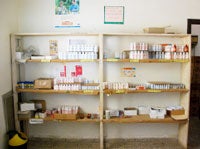 Regional partnerships
Regional partnerships
Although the Region of the Americas has seen a decline in its share of official development assistance, it has produced or participated in a wealth of alliances, partnerships, and joint initiatives that promote equitable development and health. Regional initiatives formed specifically to promote the MDGs include the Newborn Health Alliance for Latin America and the Caribbean2, the Regional Inter-Agency Task Force for Maternal Mortality Reduction3 (GTR), the Safe Motherhood Initiative4, and the Pan American Alliance for Nutrition and Development5.
These and similar alliances among UN agencies and other organizations active in the Region have increased visibility and political commitment, created synergies, and reduced overlap and duplication of efforts among actors working toward similar goals. They have also helped the Region’s lower- and middle-income countries as well as small-island developing states access resources from major international funding sources, including the Global Alliance for Vaccines and Immunization (GAVI), Spain’s MDG Achievement Fund, and the Global Fund to Fight AIDS, Malaria and Tuberculosis.
 Go to next Chapter
Go to next Chapter
1 Non-endemic countries in the Americas have recently reported to PAHO/WHO an average of 1,825 cases of malaria (imported and introduced) each year, most of them in the United States (1,414) and Canada (385).
2Members include PAHO/WHO, the United Nations Children’s Fund (UNICEF), the US Agency for International Development (USAID), ACCESS, BASICS, CORE Group, Plan USA, University Research Co./Center for Human Services (URC/CHS), Save the Children/Saving Newborn Lives, the Latin American Association of Pediatrics (ALAPE), the International Confederation of Midwives (ICM), and the Latin American Federation of Societies of Obstetrics and Gynecology (FLASOG).
3Members include PAHO/WHO, UNICEF, the UN Population Fund (UNFPA), USAID, the World Bank, the Inter-American Development Bank (IDB), the Population Council, Family Care International (FCI), the Latin American Federation of Societies of Obstetrics and Gynecology (FLASOG), the Pan-American Federation of Nursing Professionals (FEPPEN), and the International Confederation of Midwives (ICM).
4Members include the members of the Regional Inter-Agency Task Force for Maternal Mortality Reduction (GTR) as well as the Organization of American States (OAS) and the La Caixa Foundation of Spain.
5Members include PAHO/WHO, the UN Development Program (UNDP), UNICEF, ECLAC, UNFPA, the International Labor Organization (ILO), the World Food Program (WFP), the UN Office on Drugs and Crime (UNDOC), the UN Joint Program on HIV/AIDS (UNAIDS), the UN Development Fund for Women (UNIFEM), and the UN Office for Project Services (UNOPS).

